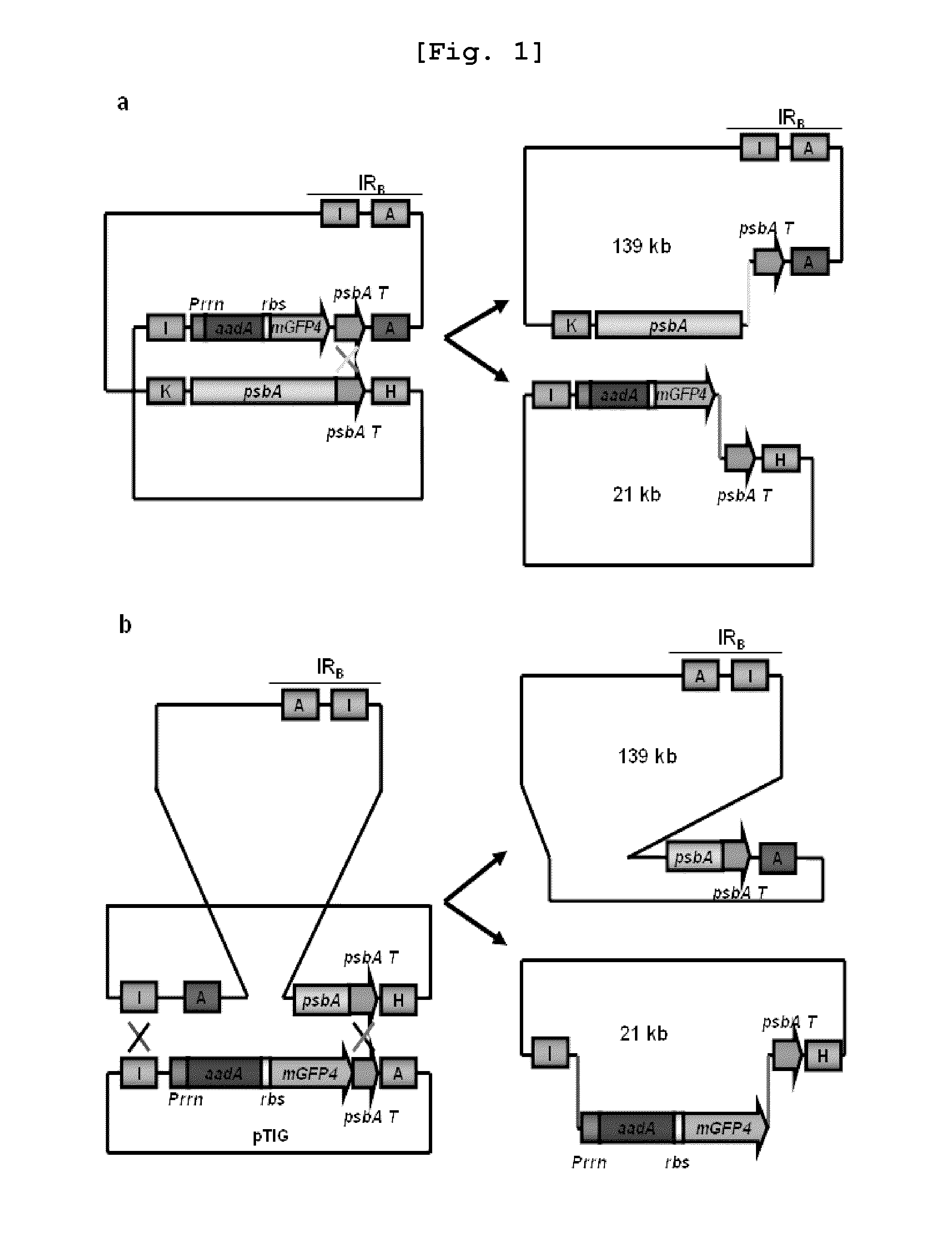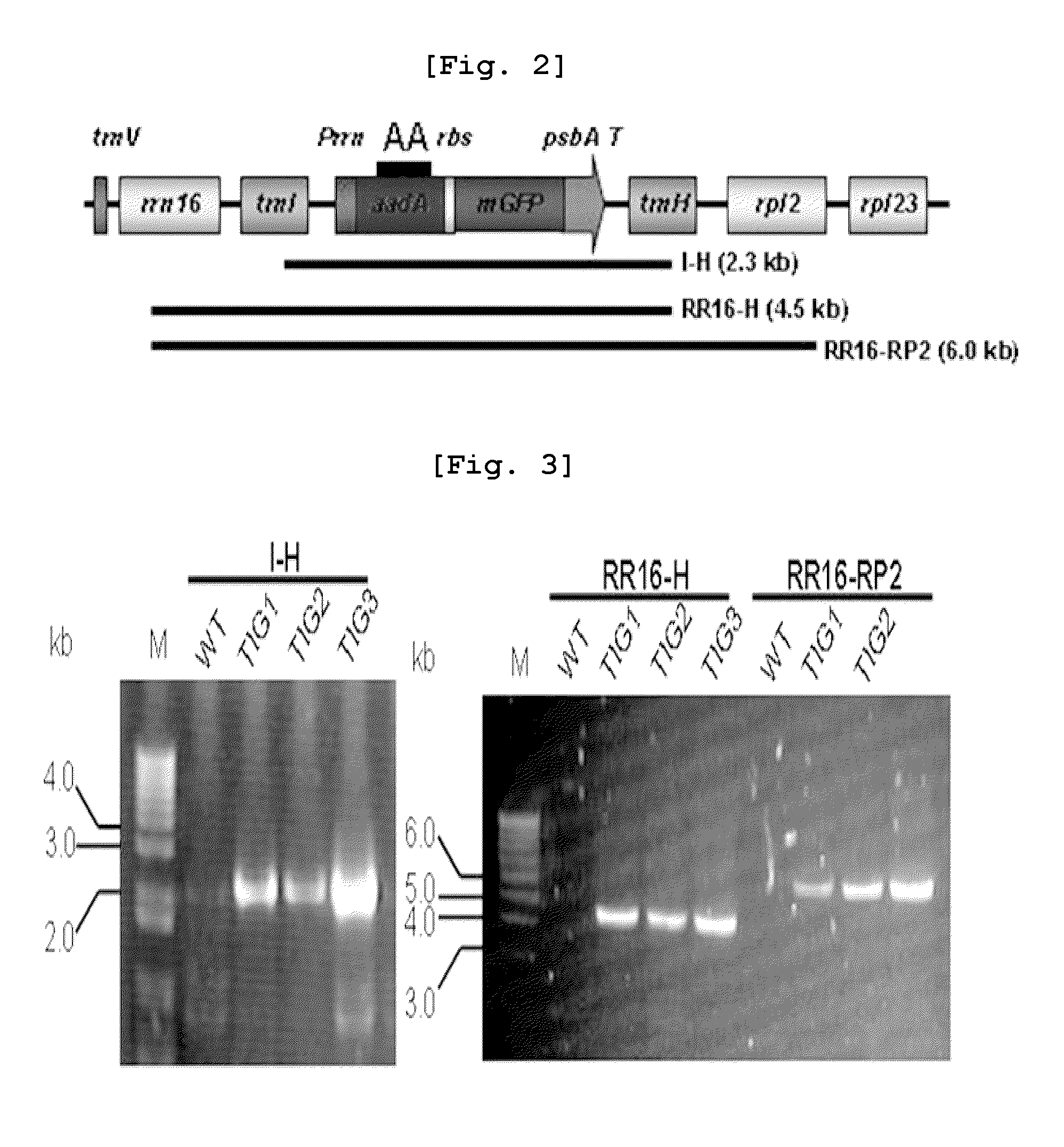Plastid transformation system to prevent the intramolecular recombination of transgene
a plastid and transgene technology, applied in the field of expression vectors, can solve the problems of poor transformation efficiency of plants other than tobacco, low transformation efficiency, and insufficient transformation of plastids, and achieve the effect of preventing a second homologous recombination
- Summary
- Abstract
- Description
- Claims
- Application Information
AI Technical Summary
Benefits of technology
Problems solved by technology
Method used
Image
Examples
example 1
Confirming the Occurrence of a Second Recombination in Plant Transformants Produced with Conventional Chloroplast Transformation Vectors
[0053]The present inventors constructed CtVG (FIG. 8b), a typical chloroplast transformation vector with a GFP insert in the same way as the pTIG vector (Jeong, S. W., Jeong, W. J., Woo, J. W., Choi, D. W., Park, Y. I., Liu, J. R., Plant Cell Rep., 22:741˜751, 2004) by modifying the chloroplast transformation vector CtV2 (Guda, G., Lee, S. B., Daniell, H., Plant Cell Rep., 19:257˜262, 2000). Chloroplast transformation was carried out with CtVG, and the occurrence of a second recombination in the transformants was investigated as follows.
[0054]10˜100 ng of genomic DNA isolated from the plastid transformants was used as the template for polymerase chain reaction (PCR). PCRs were performed using exTaq polymerase (Takara, Japan) or AccuPower® PCR premix (Bioneer, Korea) under the conditions of a 5 minutes pre-denaturation at 94° C. followed by 30 cycles...
example 2
Constructing a Plastid Transformation Vector Comprising the Clp Promoter from Rice (Oryza sativa) and the rrnB1 / B2 Terminator from E. coli
[0062]Using rice genomic DNA as a template, a DNA fragment comprising the clp promoter was amplified by PCR with rclpP5 primer (SEQ. ID NO: 3) and rclpP3 primer (NO 4) and subcloned into the pCR2.1-TOPO vector (Invitrogen, USA). The exTaq DNA polymerase (Takara, Japan) was employed for the PCR under the conditions of a 5-minute pre-denaturation at 94° C. followed by 30 cycles of a 1-minute denaturation at 94° C., a 1-minute primer annealing at 55° C. and a 1-minute extension at 72° C., and followed by a final extension for 10 minutes at 72° C. The amount of rice genomic DNA template was 10˜100 ng. The sequence of rice clp promoter (SEQ. ID NO: 1) was confirmed by nucleotide sequencing. The rrnB1 / B2 terminator (SEQ. ID NO: 2) was prepared by a digestion of pHCE19, a commercial E. coli expression vector (Takara, Japan), with PstI / HincII to obtain a...
example 3
Producing Transgenic Plants by the Plastid Transformation Vector pRclPADGHT
[0064]Plastid transformation was carried out as follows using the vector pRclPADGHT. As a control group, the transformation was carried out with CtVG, a conventional transformation vector having the rrn promoter and psbA terminator.
[0065]Wild type tobacco (Nicotiana tabacum var. Samsun) seeds were allowed to germinate in vitro for 8 weeks and then the leaves were taken and placed on an MS medium (Murashige, T., Skoog, F., Physiol. Plant, 15:473˜49, 1962) with 1 mg / L benzyl aminopurine (BAP) and 0.1 mg / L □-napthalene acetic acid (NAA) for plastid transformation. Using CaCl2 and spermidine, a plastid transformation vector carrying gfp as a heterologous gene was coated onto gold particles having an average diameter of 0.6 m. The particles were then delivered to the leaves at an acceleration power of 1,100 psi with a target distance of 9 cm in a vacuum of 28 inches (Hg) by the PDH-1000 / He gene delivery system (Bi...
PUM
| Property | Measurement | Unit |
|---|---|---|
| pH | aaaaa | aaaaa |
| diameter | aaaaa | aaaaa |
| diameter | aaaaa | aaaaa |
Abstract
Description
Claims
Application Information
 Login to View More
Login to View More - R&D
- Intellectual Property
- Life Sciences
- Materials
- Tech Scout
- Unparalleled Data Quality
- Higher Quality Content
- 60% Fewer Hallucinations
Browse by: Latest US Patents, China's latest patents, Technical Efficacy Thesaurus, Application Domain, Technology Topic, Popular Technical Reports.
© 2025 PatSnap. All rights reserved.Legal|Privacy policy|Modern Slavery Act Transparency Statement|Sitemap|About US| Contact US: help@patsnap.com



